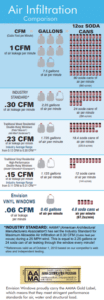As the calendar ushers in spring, homeowners face the dual challenges of April’s relentless showers and May’s pollen count. These seasonal phenomena underscore the critical role of windows in not only framing our view of the world, but also in safeguarding our homes against environmental elements while enhancing indoor air quality. This comprehensive guide includes special considerations for specific regions, health benefits, and cost implications. We’ll also highlight the main reasons for upgrading your windows to effectively tackle the unique challenges of spring’s air pollution and rainfall.
Combatting April Air Pollution with Enhanced Windows
In regions with lots of industrial or natural pollutants – like pollen – air quality significantly deteriorates, making it important for homeowners to keep their indoor air clean. Upgraded windows with superior air leakage ratings become essential in these areas, acting as a first line of defense against keeping out pollutants and allergens. This is particularly crucial for people with respiratory conditions or allergies, for whom spring’s air can pose serious health risks
Air Leakage Ratings: Your First Line of Defense
When considering new windows, an important feature to consider is the air leakage rating. Measured in cubic feet per minute (CFM), these ratings correlate to the amount of air that flows through a closed window every minute. The higher the number, the more air that is slipping through the edges and cracks of your window pane. For example, the window industry standard is 0.30 CFM, which means that almost one-third of a cubic foot of air is allowed to pass through the window every minute, and the window is only 70% sealed.
Low air leakage ratings are critical in keeping out air pollutants. In areas prone to high air pollution – or if you’re sensitive to seasonal allergies – selecting windows with ratings closer to 0.1 CFM (90% sealed) can dramatically improve your home’s air quality. The result is a house with lots of clean, breathable air and offering significant health benefits. While 0.1 CFM is a decent number, high-quality windows like Window Nation’s are capable of sealing out as little as 0.6 CFM (94% sealed).
To help further explain the importance of high-quality windows for allergy sufferers, take a look at the chart below.
Weathering May Showers with Confidence
The adage “April showers bring May flowers” hints at the impending moisture challenges. Regions with heavy rainfall in May can see an increased risk of water leaking past the windows, which not only threatens the home’s structure but can also lead to mold and mildew growth. Here, the choice of windows becomes a key factor in preventing moisture damage and protecting the health of the home’s occupants. Learn how to inspect your windows for leaks with our helpful DIY guide.
Preventing Water Intrusion: The Role of Window Upgrades
Upgrading to modern windows equipped with advanced sealing technologies such as WINTeQ Low Expansion Foam and OSI® QUAD® Window, Door and Siding Sealant is key – especially in regions known for their wet springs. This can prevent many issues associated with leaking windows. Beyond immediate comfort, these upgrades are an investment in the home’s long-term structural health and the wellbeing of its inhabitants.
Cost Considerations: An Investment in Your Home’s Future
While the upfront cost of window upgrades can be a concern for many homeowners, it’s essential to consider the long-term savings and value added. Energy-efficient windows can significantly reduce heating and cooling expenses, offering not just improved comfort but also substantial cost savings over time. In areas facing extreme weather patterns, the right windows can also prevent costly damage repairs related to leaks and moisture intrusion. Window Nation offers the right custom fit at affordable prices.
Regional Specificity: Tailoring Your Choices
When selecting windows, consider the specific challenges of your region—be it high pollen counts, pollution levels, or the frequency of spring showers. Energy-efficient windows tailored to these conditions not only provide immediate benefits in terms of comfort and air quality but also contribute to the overall energy efficiency and resilience of your home.
Frequently Asked Questions About Upgrading Your Windows for Spring
Q: How do new windows improve indoor air quality during high pollution months like April?
A: By choosing windows with superior air leakage ratings of 0.1 CFM or lower, you minimize the entry of pollutants, significantly improving indoor air quality—a big benefit for allergy and asthma sufferers.
Q: Can upgraded windows really help prevent water damage from heavy rains in May?
A: Absolutely. Windows designed for superior water resistance can dramatically reduce the risk of leaks and moisture-related damage.
Q: What window materials are best for my region?
A: Vinyl is the best choice for most regions, offering durability, low maintenance, and high energy efficiency. Your local climate and environmental challenges should guide your selection to ensure the best fit for your home.
Q: Are the cost savings from energy-efficient windows significant?
A: Yes, while initial investments may be higher, the reduction in monthly energy bills and potential savings from avoiding damage repairs can make energy-efficient windows financially beneficial in the long run.
In conclusion, embracing the challenges of spring with the right window upgrades can significantly enhance your home’s comfort, air quality, and energy efficiency. By considering regional specifics, prioritizing health benefits, and understanding the cost savings associated with energy-efficient windows, homeowners can make informed decisions that pay dividends for years to come.



